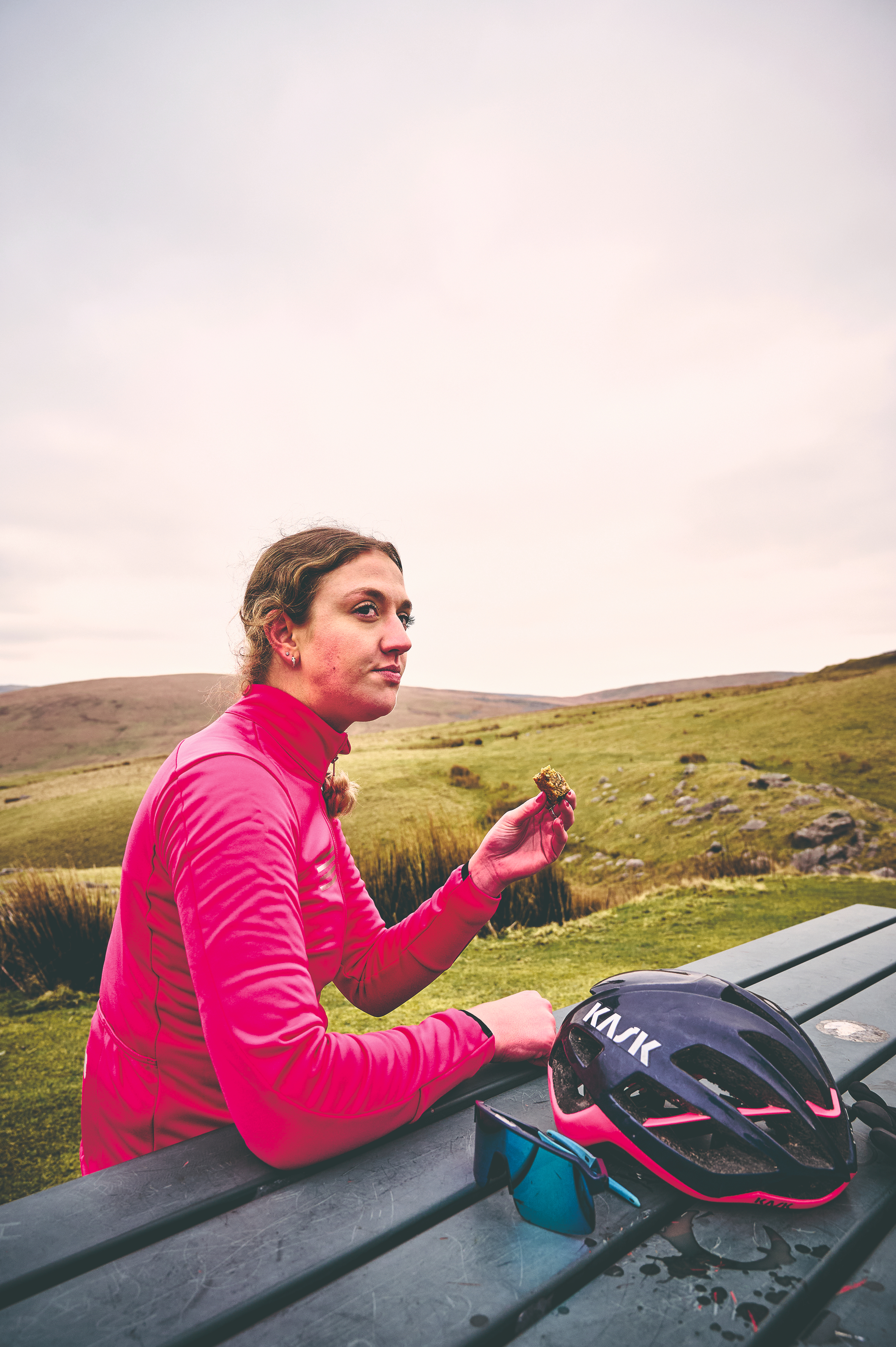“In July 2018, I was descending on my time trial bike when I slid out on a bit of gravel on a corner. It was only a minor crash, but it fractured my pelvis, my hip and my sacrum.” This was Georgia Williams’s stark wake-up call that she needed to recover from REDs, relative energy deficiency in sport. Williams, who retired in 2023, is a nine-time New Zealand national champion, 2016 Olympian, and two time Commonwealth Games medallist. Every athlete with REDs has a ‘wakeup call’ moment. My own was a sky high cholesterol result at my annual physical. It was March 2024, just weeks after I’d retired from racing pro cyclocross in Belgium. Altered lipid levels are common in REDs, and further blood work confirmed my diagnosis.
REDs occurs when an athlete fails to eat enough to fuel their training and everyday life. The condition presents an array of symptoms. Some of the most common are extreme fatigue, frequent illness and injury, poor performance or decreased adaptation to training, depression or anxiety, sleep issues and menstrual cycle dysfunction or, in men, fewer morning erections. The prevalence of REDs is unknown, with studies reporting a range of 23-80% in females and 15-70% in males. In an attempt to tighten the research, a 2023 IOC REDs consensus subgroup published a paper standardising REDs research methods.
Understanding REDs requires an appreciation of how the body allocates fuel. When energy is running low, the body prioritises movement. This makes sense from an evolutionary standpoint. If you are being chased by a tiger, running away is top priority! The calories left over after exercise represent your ‘energy availability’ (EA).
If they are insufficient, you are said to be in low energy availability (LEA). If you are persistently in LEA, you develop REDs. The body ‘turns down’ biological processes to save energy, causing REDs symptoms. A common consequence of REDs is a loss of bone density and subsequent increased fracture risk. One of the first low energy adaptations is decreased bone turnover. Our bodies should be constantly rebuilding bone, but this gets deprioritised in an energy deficit. As bone density decreases, it’s first classified as osteopenia and then osteoporosis.
Varied symptoms
One of the challenges of identifying REDs is that there isn’t a single tell-tale symptom. REDs presents differently in different bodies. The best guess is that the pattern reflects a person’s unique genetics. Loss of menstrual periods in women and fewer morning erections in men can be telltale signs of REDs. These symptoms have been emphasised in REDs education because they are so obvious. However, it’s important not to over-rely on these symptoms.
Fractures were a REDs flag for TT champ Williams
(Image credit: Getty Images)
Women who are using hormonal birth control do not have true menstrual bleeds, only a withdrawal bleed. This bleed cannot be used to assess hormonal health. Likewise, it’s possible for women to bleed monthly while experiencing subclinical ovulatory disturbance (SOD). These are cycles where ovulation may or may not occur, but critically, progesterone does not rise adequately during the luteal phase (second half of cycle). SOD can be the result of LEA. Dr Nicky Keay is a medical doctor and hormones specialist. “Loss of period may be just the tip of the iceberg when it comes to adaptive change to low energy availability.” She suggests basal body temperature tracking as a non-invasive means of monitoring hormone health.
Williams’s REDs was marked by the loss of her periods, a condition called hypothalamic amenorrhea (HA). She first brought this up to a doctor in 2014, when she came off the pill and her periods did not return. The doctor told her this was normal for athletes, which was incorrect, as HA is not normal or healthy for anyone. “I was like, if the doctor is telling me it’s fine, it must be fine,” said Williams. Eventually, in 2018, while preparing for the Commonwealth Games, she underwent medical testing with her federation, reporting that she hadn’t had a period in “a few years”. The doctor suggested a bone-density scan, which found osteoporosis and osteopenia in Williams’s lower spine and hips. Even so, she was cleared to compete, and even won a silver medal, but the doctor stayed in touch.
The latest race content, interviews, features, reviews and expert buying guides, direct to your inbox!
I realised, if just slipping on a corner fractures three bones, my bones are obviously not good
Georgia Williams
“I had a really good season on the road. I was racing really well, but this doctor kept reaching out to me,” said Williams. “He kept saying, ‘You need to get your period back. Your bones are not good.’ I was just sort of brushing it off. I felt fine.” Then came the crash. “I realised, if just slipping on a corner fractures three bones, my bones are obviously not good,” Williams recalled. “What are they going to be like when I’m 60?”
While Williams’s REDs presentation was fairly typical for a woman, mine wasn’t. I never lost my period. I had several REDs symptoms: extreme fatigue, anxiety and panic, hot flushes, night sweats, frequent bonking and hypoglycaemia episodes, poor circulation, and GI issues. When I lost a lot of weight, friends worried, but we were all reassured by my period, as we assumed menstruation was a guarantor of health. In fact, I had REDs for six years. As Keay explained, I likely had subclinical ovulatory disturbance, which negatively affects one’s lipid profile.
REDs symptoms

(Image credit: Future)
The cycling community urgently needs to increase our awareness of REDs. Coaches and physios ought to be able to recite REDs symptoms by heart. Not all athletes with REDs present the classic symptoms – so it can be hard to spot.
Familiarise yourself with these warning signs: Menstrual dysfunction in women, decreased frequency of morning erections in men, fatigue, decreased libido, anxiety/depression, frequent illness, GI dysfunction, frequent injuries, reduced performance/ training adaptation, impaired neurocognitive function, sleep disturbances
REDs and women
REDs can affect anyone who underfuels: riders at all levels – professional, amateur, junior, elite and Masters – men and women. However, research and clinical experience suggest that REDs disproportionately affects women. Performance nutritionist Rachel Chesters is a PhD researcher at the University of Birmingham specialising in low energy availability and REDs. “Females seem to be more sensitive to low energy availability,” said Chesters. “One theory is that reproduction is more energetically taxing on a female body. It makes sense for women’s reproductive systems to be compromised by LEA. If you don’t have enough energy to sustain yourself, it’s going to be really challenging to grow, carry and feed a baby as well.’
Women are physiologically more vulnerable and we experience greater societal pressure to be weight conscious. Consider the teenage boy who during his growth spurt eats vast quantities of food. His parents laugh and add more food to the grocery trolley. Meanwhile, most girls are taught, mother-to-daughter, to eat in moderation and avoid weight gain.
“We know there is a clear difference between men and women in the prevalence of disordered eating, which is a significant contributing factor to REDs,” said Chesters. However, the nutritionist suspects REDs is under-reported in men. “The symptoms are more obvious in women,’ said Chesters, “and it might be more culturally acceptable for women to say, ‘I am struggling with this’, because more female athletes are speaking about it.”
Disordered eating
REDs is divided into two categories: intentional, where an athlete restricts intake with the intent of losing weight, and unintentional, where an athlete inadvertently under-fuels, often as a result of miscalculating their caloric needs. Many athletes make the mistake of following nutritional advice aimed at less active people. “Think of guidance urging low sugar or no processed foods,” said Chesters. “[Some athletes] respond by eating a high-volume, high-fibre sort of diet. It keeps them really full, may cause stomach issues around training, and makes it difficult to eat enough overall.”

Coogan Cisek’s REDs was triggered by a carb-restricted diet
(Image credit: Getty Images)
Williams’s descent into REDs was entirely without intent. “I thought what I was eating was fine,” she said. “Healthy food and vegetables, all really low-calorie – but it just wasn’t enough to supply the demands of training. I was never really underweight. My body was so stressed that it was probably holding onto what I did eat.” For an athlete in unintentional REDs, Chesters educates and addresses their misconceptions, helping them to change their eating habits, restore energy balance and recover.
In contrast to Williams’s, my REDs was caused by intentional calorie restriction. In 2018, I began working with a nutritionist who taught me ‘carbohydrate periodisation’ including how to lose weight by decreasing carbohydrates. I clustered all my carbohydrate intake before, during and after training, eating low-carb at all other times. The process, subsequent six-kilo weight loss, and temporary performance improvement proved addictive. For the better part of two years, I was consumed by my eating disorder. In 2020, I worked with a sports psychologist and toned down my disordered behaviours. However, I was not assessed for REDs. My metabolism having slowed, I returned to my original weight – but unknowingly I remained in REDs.
“Disordered eating behaviours include restrictive eating, fasting, self-inducing vomiting or limiting food groups, such as low-carb diets,” said Chesters. “In practice, disordered eating also involves more normalseeming food restrictions, whether that’s small portions, restricting foods believed to be ‘bad’ or too energydense, or so-called clean-eating.” It can be hard to distinguish between disciplined ‘athlete eating’ and disordered eating. “For me it’s about whether there is underlying pathology to the behavior,” said Chesters. “I look at the intent, frequency, duration and the impact of the behaviour on the athlete’s physical, mental and emotional health.”
The road to recovery
How to avoid REDs
ATHLETES SHOULD: Understand their daily calorie and macronutrient needs l Follow best practice for pre-, intra- and postexercise fuelling. l Re-evaluate fuelling needs with increases or decreases in training. l Attempt weight loss only under the supervision of a qualified nutritionist l Avoid fasted training l Track their menstrual cycle if not on hormonal birth control. Look for changes in cycle length. l Consider using basal body temperature tracking to confirm ovulation.
COACHES SHOULD: Watch for disordered eating behaviours. Athletes should be comfortable eating all foods in moderation, dining out and eating with others. l Look out for REDs symptoms.
FEDERATIONS SHOULD: Provide REDs and eating disorder education for coaches and athletes. l Publish screening tools as detailed in the IOC REDs Clinical Assessment Tool.
Finding qualified assistance is one of the greatest challenges of REDs recovery. It is a ‘young’ condition, first recognised by the IOC in 2014. Odds are, your GP has never heard of REDs. A REDs care team should include a physician, nutritionist and ideally a psychologist with experience in eating disorders. The best resource for locating REDs providers in the UK and US is ‘Project RED-S’ (red-s.com). They also provide an informative letter that athletes can take to their GP.
REDs recovery entails correcting the energy imbalance. The nutritionist helps the athlete with volume, food choices and timing. A doctor may track recovery via regular blood work. Athletes may take a break from training and/or racing, depending on their health and life circumstances. Coincidentally, Williams and I took a similar recovery approach. For three to four months, we didn’t race or do any intensity. We reduced volume, added rest days and massively scaled-up fuelling, especially around training.

Recovery entails correcting the energy imbalance
(Image credit: Future)
Recovery from malnourishment or an eating disorder often involves temporary weight gain to above one’s healthy weight. Both Williams and I experienced this. “I gained weight as I knew I would, but from my research, I felt this was the fastest way to recover,” said Williams. “I had days where I felt really bad about my body and it was a struggle, but I just kept telling myself my health was more important than cycling.” This ‘overshoot’ weight usually returns to healthy weight within a year of recovery. “Initially, my climbing did suffer,” added Williams, “but I was still really strong on the flats. I had some really good races, and I still had really good power. I slowly lost the weight and could sustain the power.”
For Williams and me, REDs took a big part of our careers and our health. However, recovery yielded rewards. Williams raced five more years as a pro. I’ve gained a level of psychological health that I couldn’t have envisioned a couple years ago. I fully agree with Williams when she says: “Health is more important than cycling.”
This feature originally appeared in Cycling Weekly magazine. Subscribe now and never miss an issue.

